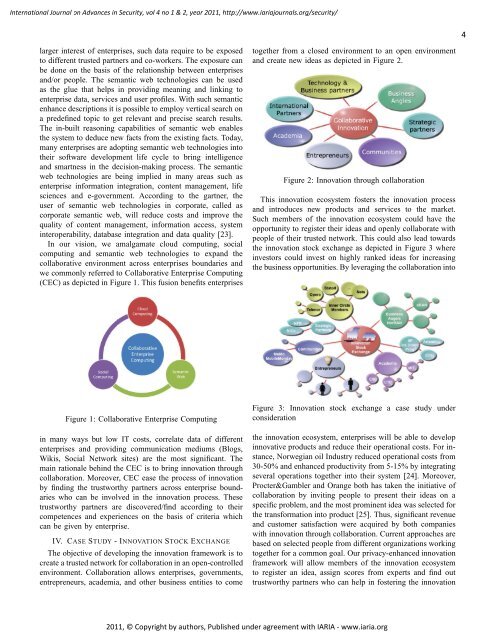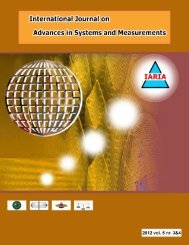Fault Tolerance Framework using Model-Based - IARIA Journals
Fault Tolerance Framework using Model-Based - IARIA Journals
Fault Tolerance Framework using Model-Based - IARIA Journals
Create successful ePaper yourself
Turn your PDF publications into a flip-book with our unique Google optimized e-Paper software.
International Journal on Advances in Security, vol 4 no 1 & 2, year 2011, http://www.iariajournals.org/security/<br />
larger interest of enterprises, such data require to be exposed<br />
to different trusted partners and co-workers. The exposure can<br />
be done on the basis of the relationship between enterprises<br />
and/or people. The semantic web technologies can be used<br />
as the glue that helps in providing meaning and linking to<br />
enterprise data, services and user profiles. With such semantic<br />
enhance descriptions it is possible to employ vertical search on<br />
a predefined topic to get relevant and precise search results.<br />
The in-built reasoning capabilities of semantic web enables<br />
the system to deduce new facts from the existing facts. Today,<br />
many enterprises are adopting semantic web technologies into<br />
their software development life cycle to bring intelligence<br />
and smartness in the decision-making process. The semantic<br />
web technologies are being implied in many areas such as<br />
enterprise information integration, content management, life<br />
sciences and e-government. According to the gartner, the<br />
user of semantic web technologies in corporate, called as<br />
corporate semantic web, will reduce costs and improve the<br />
quality of content management, information access, system<br />
interoperability, database integration and data quality [23].<br />
In our vision, we amalgamate cloud computing, social<br />
computing and semantic web technologies to expand the<br />
collaborative environment across enterprises boundaries and<br />
we commonly referred to Collaborative Enterprise Computing<br />
(CEC) as depicted in Figure 1. This fusion benefits enterprises<br />
Figure 1: Collaborative Enterprise Computing<br />
in many ways but low IT costs, correlate data of different<br />
enterprises and providing communication mediums (Blogs,<br />
Wikis, Social Network sites) are the most significant. The<br />
main rationale behind the CEC is to bring innovation through<br />
collaboration. Moreover, CEC ease the process of innovation<br />
by finding the trustworthy partners across enterprise boundaries<br />
who can be involved in the innovation process. These<br />
trustworthy partners are discovered/find according to their<br />
competences and experiences on the basis of criteria which<br />
can be given by enterprise.<br />
IV. CASE STUDY - INNOVATION STOCK EXCHANGE<br />
The objective of developing the innovation framework is to<br />
create a trusted network for collaboration in an open-controlled<br />
environment. Collaboration allows enterprises, governments,<br />
entrepreneurs, academia, and other business entities to come<br />
together from a closed environment to an open environment<br />
and create new ideas as depicted in Figure 2.<br />
Figure 2: Innovation through collaboration<br />
This innovation ecosystem fosters the innovation process<br />
and introduces new products and services to the market.<br />
Such members of the innovation ecosystem could have the<br />
opportunity to register their ideas and openly collaborate with<br />
people of their trusted network. This could also lead towards<br />
the innovation stock exchange as depicted in Figure 3 where<br />
investors could invest on highly ranked ideas for increasing<br />
the business opportunities. By leveraging the collaboration into<br />
Figure 3: Innovation stock exchange a case study under<br />
consideration<br />
the innovation ecosystem, enterprises will be able to develop<br />
innovative products and reduce their operational costs. For instance,<br />
Norwegian oil Industry reduced operational costs from<br />
30-50% and enhanced productivity from 5-15% by integrating<br />
several operations together into their system [24]. Moreover,<br />
Procter&Gambler and Orange both has taken the initiative of<br />
collaboration by inviting people to present their ideas on a<br />
specific problem, and the most prominent idea was selected for<br />
the transformation into product [25]. Thus, significant revenue<br />
and customer satisfaction were acquired by both companies<br />
with innovation through collaboration. Current approaches are<br />
based on selected people from different organizations working<br />
together for a common goal. Our privacy-enhanced innovation<br />
framework will allow members of the innovation ecosystem<br />
to register an idea, assign scores from experts and find out<br />
trustworthy partners who can help in fostering the innovation<br />
2011, © Copyright by authors, Published under agreement with <strong>IARIA</strong> - www.iaria.org<br />
4







